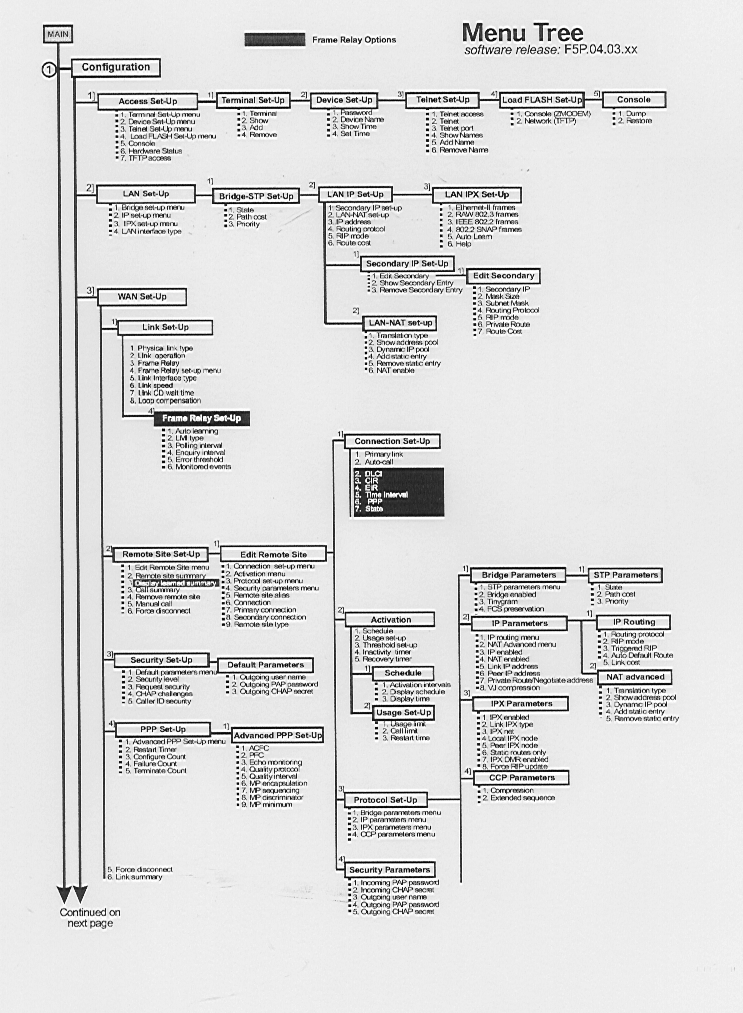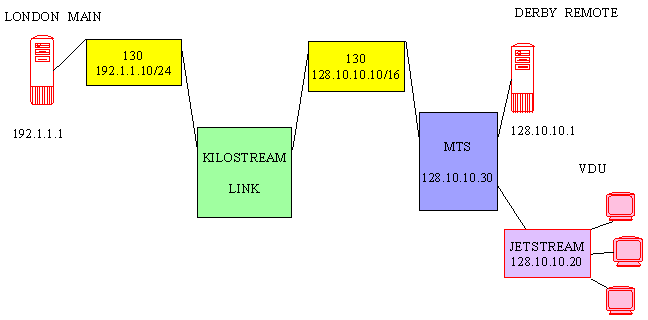

FECO: |
COMMS # 63 |
MODIFICATION NO: |
N/A |
PRODUCT: |
CHASE IO-LINK-130 KILOSTREAM ROUTER |
SUB-ASSEMBLY: |
N/A |
ESTIMATED MAN HOURS: |
N/A |
CLASS OF CHANGE: |
INFORMATIONAL |
REASON FOR CHANGE: |
INTRODUCTION OF |
RELATED FECO/AB |
FECO COMMS # 62, 64 & 65 |
1.1 This is to introduce the Chase IO-LINK-130, it is the Chase entry level Kilostream Bridge
Router.
1.2 The 130 units are small, approx 4.5 in wide by 6in deep by 1.5in high; coloured black with
four LED’s in line across the front. See over.
1.3 The 130 has one LAN interface (MIDI & MIDIX) and one WAN interface. There is also the
console connection. The console and LAN interfaces are RJ45. The WAN interface is
25pin D Type Female.
1.4 The 130 will interface with other Chase products including the Chase IO-LINK-PRO, and
the IO-LINK-CENTRAL.
2. MEC IDENTITY
The MEC ID is
CHASE-IOLINK-130
3. CABLE SPECS
Network connection to hub Cable Type JF
Cable Type KH
Network connection to Ethernet Controller. Cable Type JP
Console Port to VDU Cable Type KJ
Console Port to PC Cable Type JF + RJ45 to 9pin converter
130 Universal WAN to NTU
4. FRONT & REAR VIEWS


5. INITIAL CONFIGURATION
5.1 Connect a VDU set to 9600 8-1-N & VT100, to the Console Port with a Cable Type KJ.
5.2 Power on
the IOLINK-130 and view the Start-up Testing and Initialising Sequence on the
VDU Screen. At the prompt Press ENTER to access console, enter <CR>
5.3 At LOGIN MENU Select 1 Login
5.4 At Password prompt Enter BRIDGE <CR> This is case sensitive.
5.5 The MAIN MENU will be displayed
Option Value Description
1. Configuration menu - Define operating parameters
2. Statistics menu - Device LAN and WAN statistics
3. Diagnostics menu - Access troubleshooting tools
4. Network events menu - View network event history
5. Save configuration - Save configuration immediately
6. Logout - End operator session
7. Help - Read menu introduction
5.6 All configurations are menu driven
6. CONVENTIONS USED
6.1 The Menu System is in the form of a tree shown over.
To go forwards through the Menu System Enter the Option Number required, usually you
do not need to follow this with a <CR>.6.2 To select an option enter the Option number and enter the required input. If the input has
fixed options, then these will be displayed; just enter enough of the characters for it to be
unique. i.e. jun for june, but only d for december. For options like IP addresses they must
be entered in full. Most entries require a <CR> to terminate data input. Any entry that is not
acceptable, like an out of range IP Address, will be identified as unacceptable and you will
be invited to try again.
To toggle between two options e.g. enabled and disabled, just enter the option number,
and it will prompt "yes" to enable/disable parameter. Enter yes <CR> to complete the
toggle.6.3 To go backwards through the Menu System use the TAB key.
To return to the Main Menu Enter =6.4 At the end of each sequence it is advisable to save the configuration , From the Main
Menu select the option Save configuration. When completed Configuration saved will
be displayed at the bottom of the screen.
On completion of all set-ups Save configuration and also carry out a soft reset, from the
Main Menu select Diagnostics and then Soft reset.6.5 A Soft reset can be used to reset some minor problems.
6.6 NOTE, there may be some variation in menus and the menu numbers between
different units, which is why the set-up procedures do not give the numbers, but
do give the description
7. REQUIREMENTS
Before a 130 can be
configured the following must be available:-
Network diagram of the
complete network
Name (preferrably
geographical ie.HULL) of both Routers.
IP Address and Subnet Mask of
both Routers.
Type of leased line.
For Optional Customer
Preference settings:-
PAP, CHAP Passwords.
Source/Destination IP
Addresses of the frames.
8. DEFAULT
For a new IOLINK-130 to reset
the factory default settings:
From the Main Menu Select Diagnostics
From the Diagnostics Menu Select Full Reset.
After a Full Reset you will be prompted for the Terminal Type, Enter vt100 <CR>
9. PART OF MENU TREE over

10. IOLINK-130 CONFIGURATION
A typical network is shown at the end of this FECO. Note it can be easier to identify sites by their geographical names.
The convention used is to nominate one site as the MAIN and the other as the REMOTE.
Each site will probably be different, but a sample configuration is detailed below.
11. TYPICAL SET-UP FOR THE NETWORK DIAGRAM SHOWN.
12. MAIN 130 (LONDON Site )Set-up
12.1 It is always best to reset the factory default settings before a new configuration is set.
If the unit has been set-up before, you may wish to record the settings before wiping it.
TO RESET TO FACTORY SETTINGS:
From the Main Menu Select Diagnostics
From the Diagnostics Menu Select Full Reset.
12.2 After a Full Reset you will be prompted for the Terminal Type, Enter vt100 <CR>
12.3 At LOGIN MENU Select 1 Login
12.4 At Password prompt Enter BRIDGE <CR> This is case sensitive.
12.5 from Main Menu select Configuration
select Access set-up
select Device set-up
select Device name and type in router name e.g. LONDON
select Set time type in using yyyy-mm-dd format
type in using hh:mm:ss format
select Show time to confirm current time and date settings are correct.
TAB back to the previous menu.
select TFTP access and toggle it to enabled
TAB back to the previous menu.
select LAN set-up
select Bridge set-up and toggle it to disabled type in yes at prompt
TAB back to the previous menu.
select IP set-up
select IP address and type in using the format nnn.nnn.nnn.nnn
e.g. 192. 1 . 1 . 10 <CR>
Now enter the subnet mask size 24 for 255.255.255.0
16 for 255.255.0.0
8 for 255.0.0.0
e.g. 24 <CR>
TAB back to the previous menu. TAB again.
12.6 select Bridging set-up
select Bridge forwarding type in yes at the prompt to toggle it to disabled
TAB back to the previous menu.
select IPX routing set-up
select IPX routing type in yes at the prompt to toggle it to disabled
select IPX forwarding and toggle it to disabled
TAB back to the previous menu.
12.7 KILOSTREAM set-up
from Main Menu select Configurationselect WAN set-up
select Link set-up and Enter the link interface slot number 1
select Link operation and toggle it to disabled
select Frame Relay and toggle it to disabled
select Link speed – set to required speed in kbps e.g. 64 for 64kbps.
TAB back to the previous menu.
select Remote site set-up
select Remote site summary to show existing set-ups and templates
For the IOLINK-130 Leased Line the LEASED_TEMPLATE Id is 43
select Edit remote site Enter name of remote site e.g. DERBY <CR>
Enter: Template id or alias ( or none )
43 <CR>
Ensure that this name e.g. DERBY is now displayed in the Remote site alias
select Connection set-up
select Primary link – set to slot number 1 <CR>
select Auto-call toggle it to enabled
TAB back to the previous menu.
12.8 from Edit Remote Site 1 Menu
select Protocol set-up
select Bridge parameters
select Bridge enabled and toggle it to disabled
TAB back to the previous menu.
select IP parameters
select IP routing
select Routing protocol and set it to rip2
TAB back to the previous menu. TAB again.
select IPX parameters
select IPX enabled and toggle it to disabled
TAB back to the previous menu.
select Multilink protocol and toggle it to disabled
TAB back to the previous menu.
select Primary connection and toggle it to Leased
Press = to return to the main menu.
select Configuration
select WAN set-up
select Link set-up
select Link interface type and type in V11 <CR>
select Link operation and toggle it to enabled
Press = to return to the main menu.
from Remote Site Set Up Menu
select Display summary and check that all the entries are now correct.
13. Optional Security
13.1 Before implementing Optional Security, test the link thoroughly.
14. Optional Security setup
14.1 To set PAP or CHAP only set items required.
Default PAP password and CHAP secret set to BRIDGE.
from WAN Set-Up menu select Remote site set-upselect Edit remote site
type in the remote site id or alias e.g. DERBY
select Security parameters
select Incoming PAP password and enter DERBY ( remote site name )
select Outgoing user name and enter LONDON ( local site name )
select Outgoing PAP password and enter LONDON ( local site name )TAB back to the previous menu. TAB again. TAB again to WAN set-up Menu
select Security set-up
select Security level and enter PAP
select Request security and enter always
select CHAP challenges and enter oncePress = to return to the main menu.
select Save configuration
Note changes made here will not take effect until the link has been disabled and re-enabled.
14.2 After implementing Optional Security, retest the link thoroughly.
15. Optional Firewall setup
none - Specify local DNS IP address15.1 Only set items required.
15.2 from Configuration menu select Applications set-up
select Firewall set-up
select WAN firewall set-up enter Remote site number or alias
e.g. DERBY
select Firewall and enter inbound, outbound, both, or disabledfrom Remote Site Firewall Menu
select Designated servers and the following menu will be displayedOption Value Description
1. E-mail (SMTP) server none - Specify E-Mail server IP address
2. POP 2/3 server none - Specify E-Mail server IP address
3. FTP server none - Specify FTP server IP address
4. WWW (HTTP) server none - Specify WWW server IP address
5. Telnet server none - Specify Telnet server IP address
6. Local DNS none - Specify local DNS IP address
7. Remote DNS none - Specify remote DNS IP address
8. Secondary local DNS
15.3 Set the required parameters
15.4 from Firewall set-up menu select LAN firewall setup
select Firewall and enter inbound, outbound, both, or disabled
- Network mask for dest address15.5 from Firewall LAN menu select Edit firewall entry
and the following menu will be displayed, showing sample entriesOption Value Description
1. Destination address 128.10.10.1 - Destination IP address of frame
2. Destination mask 255.255.0.0
15.6 Set the required parameters
15.7 Note changes made here might not take effect until the link
has been disabled
and re-enabled.
15.8 Press = to return to the main menu.
select Save configuration
15.9 After implementing Firewall Security, retest the link thoroughly.
16. REMOTE 130 (DERBY Site) Set-up
16.1 It is always best to reset the factory default settings before a new configuration is set.
If the unit has been set-up before, you may wish to record the settings before wiping it.
TO RESET TO FACTORY SETTINGS:
From the Main Menu Select Diagnostics
From the Diagnostics Menu Select Full Reset.
16.2 After a Full Reset you will be prompted for the Terminal Type, Enter vt100 <CR>
16.3 At LOGIN MENU Select 1 Login
16.4 At Password prompt Enter BRIDGE <CR> This is case sensitive.
16.5 from Main Menu select Configuration
select Access set-up
select Device set-up
select Device name and type in router name e.g. DERBY
select Set time type in using yyyy-mm-dd format
type in using hh:mm:ss format
select Show time to confirm current time and date settings are correct.
TAB back to the previous menu.
select TFTP access and toggle it to enabled
TAB back to the previous menu.
select LAN set-up
select Bridge set-up and toggle it to disabled type in yes at prompt
TAB back to the previous menu.
select IP set-up
select IP address and type in using the format nnn.nnn.nnn.nnn
e.g. 128. 10 . 10 . 10 <CR>
Now enter the subnet mask size 24 for 255.255.255.0
16 for 255.255.0.0
8 for 255.0.0.0
e.g. 16 <CR>
TAB back to the previous menu. TAB again.
16.6 select Bridging set-up
select Bridge forwarding type in yes at the prompt to toggle it to disabled
TAB back to the previous menu.
select IPX routing set-up
select IPX routing type in yes at the prompt to toggle it to disabled
select IPX forwarding and toggle it to disabled
TAB back to the previous menu.
16.7 KILOSTREAM set-up
from Main Menu select Configurationselect WAN set-up
select Link set-up and Enter the link interface slot number 1
select Link operation and toggle it to disabled
select Frame Relay and toggle it to disabled
select Link speed – set to required speed in kbps e.g. 64 for 64kbps.
TAB back to the previous menu.
select Remote site set-up
select Remote site summary to show existing set-ups and templates
For the IOLINK-130 Leased Line the LEASED_TEMPLATE Id is 43
select Edit remote site Enter name of remote site e.g. LONDON <CR>
Enter: Template id or alias ( or none ) 43 <CR>Ensure that this name e.g. LONDON is now displayed in the Remote site alias
select Connection set-up
select Primary link – set to slot number 1 <CR>
select Auto-call toggle it to enabled
TAB back to the previous menu.
16.8 from Edit Remote Site 1 Menu
select Protocol set-up
select Bridge parameters
select Bridge enabled and toggle it to disabled
TAB back to the previous menu.
select IP parameters
select IP routing
select Routing protocol and set it to rip2
TAB back to the previous menu. TAB again.
select IPX parameters
select IPX enabled and toggle it to disabled
TAB back to the previous menu.
select Multilink protocol and toggle it to disabled
TAB back to the previous menu.
select Primary connection and toggle it to Leased
Press = to return to the main menu.
select Configuration
select WAN set-up
select Link set-up
select Link interface type and type in V11 <CR>
select Link operation and toggle it to enabled
Press = to return to the main menu.
from Remote Site Set Up Menu
select Display summary and check that all the entries are now correct.
17. Optional Security
17.1 Before implementing Optional Security, test the link thoroughly.
18. Optional Security setup
18.1 To set PAP or CHAP only set items required.
18.2 Default PAP password and CHAP secret set to BRIDGE.
from WAN Set-Up menu select Remote site set-upselect Edit remote site
type in the remote site id or alias e.g. LONDON
select Security parameters
select Incoming PAP password and enter LONDON ( remote site name )
select Outgoing user name and enter DERBY ( local site name )
select Outgoing PAP password and enter DERBY ( local site name )TAB back to the previous menu. TAB again. TAB again to WAN set-up Menu
select Security set-up
select Security level and enter PAP
select Request security and enter always
select CHAP challenges and enter once18.3 Press = to return to the main menu.
select Save configuration18.4 Note changes made here will not take effect until the link has been disabled
and re-enabled.18.5 After implementing Optional Security, retest the link thoroughly.
19. Optional Firewall setup
none - Specify remote DNS IP address19.1 Only set items required.
19.2 from Configuration menu select Applications set-up
select Firewall set-up
select WAN firewall set-up enter Remote site number or alias
e.g. LONDON
select Firewall and enter inbound, outbound, both, or disabled19.3 from Remote Site Firewall Menu
select Designated servers and the following menu will be displayedOption Value Description
1. E-mail (SMTP) server none - Specify E-Mail server IP address
2. POP 2/3 server none - Specify E-Mail server IP address
3. FTP server none - Specify FTP server IP address
4. WWW (HTTP) server none - Specify WWW server IP address
5. Telnet server none - Specify Telnet server IP address
6. Local DNS none - Specify local DNS IP address
7. Remote DNS
19.4 Set the required parameters
19.5 from Firewall set-up menu select LAN firewall setup
select Firewall and enter inbound, outbound, both, or disabled
19.6 from Firewall LAN menu select Edit firewall entry
and the following menu
will be displayed, showing sample entries
- Network mask for dest addressOption Value Description
1. Destination address 192.1.1.1 - Destination IP address of frame
2. Destination mask 255.255.255.0
19.7 Set the required parameters
19.8 Note changes made here might not take effect until the link
has been disabled
and re-enabled.
19.9 Press = to return to the main menu.
select Save configuration
19.10 After implementing Firewall Security, retest the link thoroughly.
20. SAMPLE NETWORK DIAGRAM over
